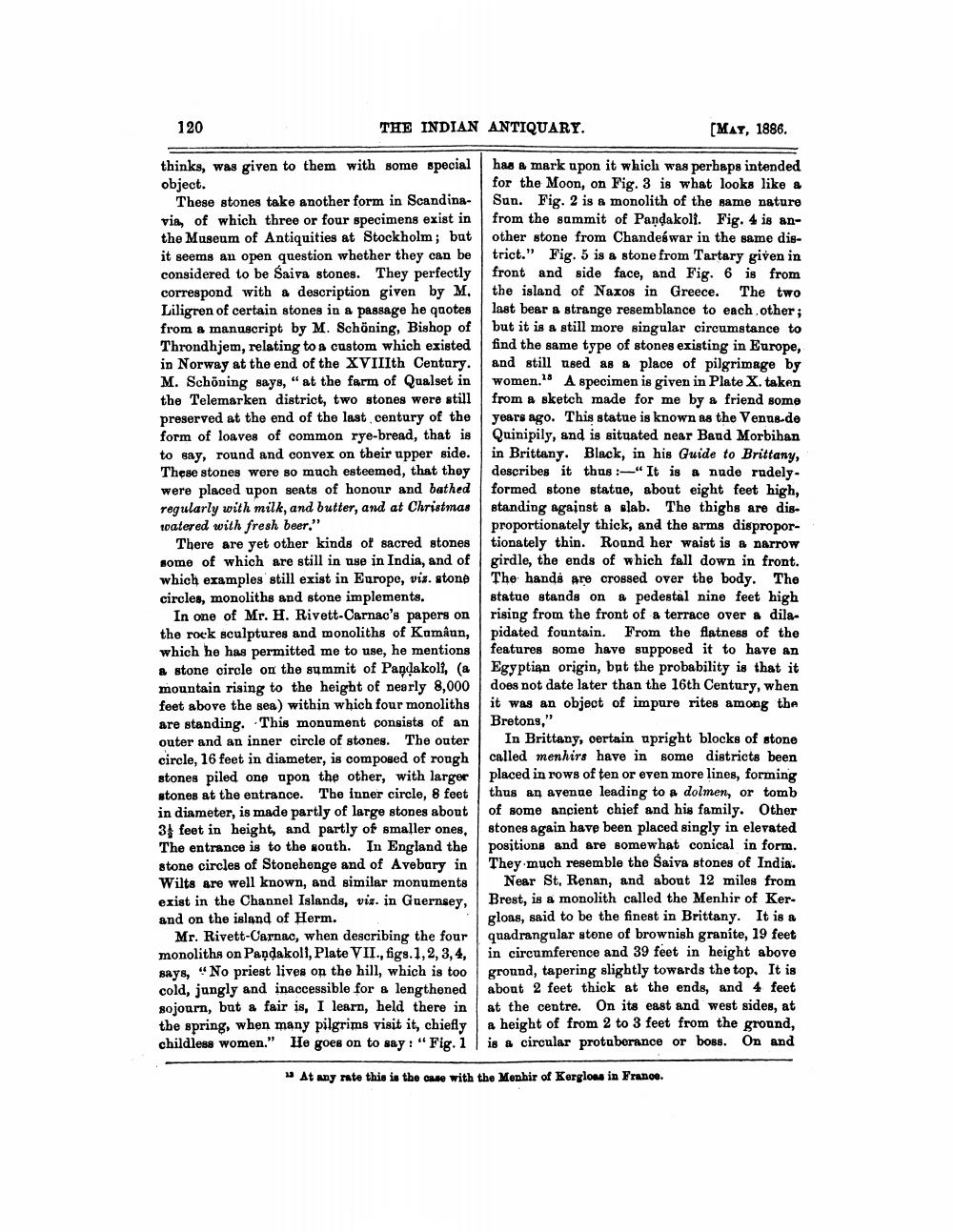________________
120
THE INDIAN ANTIQUARY.
[MAY, 1886.
thinks, was given to them with some special has a mark upon it which was perhaps intended object.
for the Moon, on Fig. 3 is what looks like a These stones take another form in Scandina- Sun. Fig. 2 is a monolith of the same nature via, of which three or four specimens exist in from the summit of Pandakolt. Fig. 4 is anthe Museum of Antiquities at Stockholm; but other stone from Chandeswar in the same disit seems an open question whether they can be trict." Fig. 5 is a stone from Tartary given in considered to be saiva stones. They perfectly front and side face, and Fig. 6 is from correspond with a description given by M. the island of Naxos in Greece. The two Liligren of certain stones in a passage he quotes last bear a strange resemblance to each other; from & manuscript by M. Schöning, Bishop of but it is a still more singular circumstance to Throndhjem, relating to a custom which existed find the same type of stones existing in Europe, in Norway at the end of the XVIIIth Century. and still used as a place of pilgrimage by M. Schöning says, " at the farm of Qualset in women." A specimen is given in Plate X. taken the Telemarken district, two stones were still from a sketch made for me by a friend some preserved at the end of the last century of the years ago. This statue is known as the Venus.de form of loaves of common rye-bread, that is Quinipily, and is situated near Baud Morbihan to say, round and convex on their upper side. in Brittany. Black, in his Guide to Brittany, These stones were so much esteemed, that they describes it thus :-“It is a nude rudelywere placed upon sents of honour and bathed formed stone statae, about eight feet high, regularly with milk, and butter, and at Christmas standing against a slab. The thighs are distoatered with fresh beer."
proportionately thick, and the arms disproporThere are yet other kinds of sacred stones tionately thin. Round her waist is a narrow some of which are still in use in India, and of girdle, the ends of which fall down in front. which examples still exist in Europe, vis, stone The hands are crossed over the body. The circles, monoliths and stone implements. statue stands on a pedestal nine feet high
In one of Mr. H. Rivett-Carnac's papers on rising from the front of a terrace over a dilathe rock sculptures and monoliths of Kamaun, pidated fountain. From the flatness of the which he has permitted me to use, he mentions features some have supposed it to have an a stone circle on the summit of Pandakoll, (a Egyptian origin, but the probability is that it mountain rising to the height of nearly 8,000 does not date later than the 16th Century, when feet above the sea) within which four monoliths it was an object of impure rites among the are standing. This monument consists of an Bretons," outer and an inner circle of stones. The outer In Brittany, certain upright blocks of stone circle, 16 feet in diameter, is composed of rough
called menhirs have in some districts been stones piled one upon the other, with larger placed in rows of ten or even more lines, forming stones at the entrance. The inner circle, 8 feet thus an avenue leading to a dolmen, or tomb in diameter, is made partly of large stones about of some ancient chief and his family. Other 3 feet in height, and partly of smaller ones, stones again have been placed singly in elevated The entrance is to the south. In England the positions and are somewhat conical in form. stone circles of Stonehenge and of Avebury in They much resemble the Saiva stones of India. Wilts are well known, and similar monuments Near St, Renan, and about 12 miles from exist in the Channel Islands, viz. in Guernsey, Brest, is a monolith called the Menhir of Kerand on the island of Herm.
gloas, said to be the finest in Brittany. It is a Mr. Rivett-Carnac, when describing the four ! quadrangular stone of brownish granite, 19 feet monoliths on Pandakoli, Plate VII., figs. 1, 2, 3, 4, in circumference and 39 feet in height above says, "No priest lives on the hill, which is too ground, tapering slightly towards the top. It is cold, jungly and inaccessible for a lengthened about 2 feet thick at the ends, and 4 feet sojourn, but a fair is, I learn, held there in at the centre. On its east and west sides, at the spring, when many pilgrims visit it, chiefly a height of from 2 to 3 feet from the ground, childless women." He goes on to say: "Fig. 1 is & circular protuberance or bobs. On and
At any rate this is the case with the Menhir of Kergioms in France.




